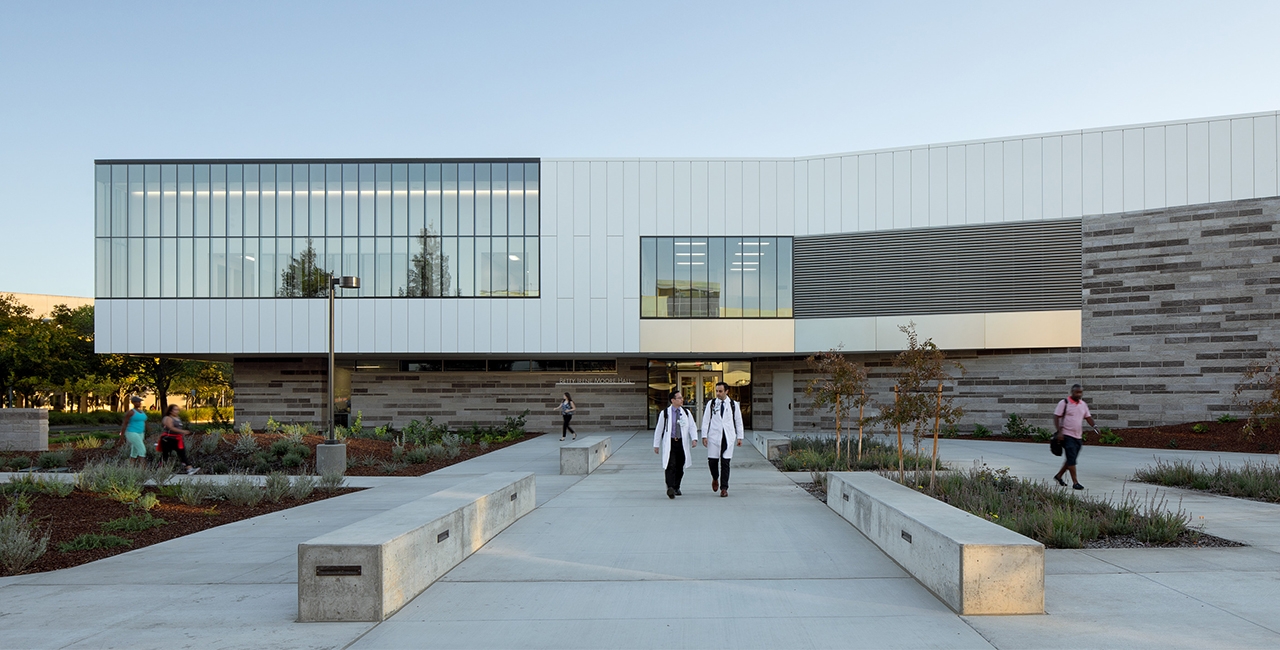
Jeremy Bittermann Photography
Case Study: Betty Irene Moore School of Nursing
Apr 25, 2018
by Jared Doescher, PE, LEED AP
Interface Engineering provided mechanical, electrical, and plumbing engineering as well as sustainable consulting services that included energy modeling and LEED(R) documentation. The project consists of a new 70,586 square foot, three story Nursing School building that includes two large Active Learning Spaces (seating between 125 to 400 students), as well as Nursing School offices and support spaces, and OSHPD documentation. The overall goal of the building was to provide a high-performance building using creative systems to control building cost.
The mechanical systems for the building consist of variable air volume air handling units serving terminal units with reheat and variable volume diffusers and radiant slabs in the main lobby areas. The campus’ central plant utilizes high efficient centrifugal chillers for chilled water and a cogeneration plant producing heating hot water. The radiant slabs provide heating or cooling based on a two-pipe change over system.
This higher education project achieved LEED(R) Gold Certification. The project was occupied in June of 2016.
Jeremy Bittermann Photography
Energy Efficiency
Significant energy management strategies were implemented into the building. Interface Engineering served as the energy analyst for the project and worked with the architect to optimize the building envelope materials and shading structures in order reduce energy consumption as well as increase occupant comfort. The final design incorporated R-19 batt insulation and R-5 continuous foam insulation for the walls and R-35 insulation on the roof deck. High performance low e-glazing is used throughout with optimized overhangs for shading.
The Nursing school building’s double height lobby is designed for student and staff to quickly travel around the building and to allow break out areas for eating, studying, and downtime. To maximize openness of the space it was important to have high ceilings, and expansive glass. Working as part of an integrated team we implemented and heated and cooled radiant slab, reducing the air handler sizes considerably, while eliminating ductwork above the ceiling and limiting conditioning to the occupied space. Energy reduction was achieved by reduction of fan power since the space is only ventilated for minimum ventilation. The use of a radiant slab increased occupant comfort and decreased energy use.
The building’s high efficiency lighting design incorporated the use of all LED lights as well as daylighting controls and occupancy sensors to achieve a 37.6% reduction in indoor lighting energy and 80.5% reduction in outdoor lighting energy. Skylights were utilized to provide daylighting for the interior Student Congregation spaces.
The combination of these energy conservation measures and optimizations resulted in a reduction of 37.1% energy cost over the ASHRAE baseline and 25.7% savings over 2013 Title 24.
Jeremy Bittermann Photography
Indoor Air Quality
This Nursing school building is designed with a heavy emphasis on indoor air quality. The entire building is designed to provide 30% more outside air at all design conditions over the ASHRAE 62.1 – 2007 ventilation requirements and with MERV-13 final filters to meet LEED IAQ requirements.
Innovation
The Betty Irene Moore School of Nursing building’s radiant system employs innovative radiant slab temperature controls to allow the slab to more quickly change mode with minimum time lag. The slab is controlled to maintain 70°F during the space temperature deadband with slab temperature varying only a few degrees in either direction for heating and cooling. This strategy is used to reduce morning warmup/cooldown time which was a concern of the University’s mechanical engineer. The system has worked successfully now through summer days over 100F and winter days in the 30’s.
Operation and Maintenance
Buy-off by the University’s Buildings and Grounds department and Engineering Review department was imperative to the design of the building. At each design phase B&G and Engineering were involved in reviewing the plans. Out of these reviews numerous meetings with B&G and Engineering were completed to get feedback on campus operations, preferred control strategies and system configurations. These meetings gave important information on the campus utilities that would not have been conveyed well over text.
The project completed Enhanced Commissioning to ensure all systems are operating per design intent. Several meetings with the controls contractor, commissioning agent, facility group, and owner’s representative were held to review building operation.
Cost Effectiveness
By utilizing the design-build project delivery system the design-build team was able to provide a building with rigorous space and efficiency requirements while maintaining construction costs. The project was brought to Schematic Design level of detail by the design team with review and input by the construction team. With this schematic design the construction team provided a bid which was used to participate in a bid competition. By providing a final construction cost to the owner at the beginning of design minimized owner and design team changes that had large cost impacts.
Additionally, design decisions were made to reduce cost and keep the building conforming with design requirements. Variable flow diffusers were utilized in conjunction with VAV terminal units throughout the building to allow sub-zoning to maximize comfort while minimizing costs.
Environmental Impact
As a result of the integrated design process to optimize the building’s envelope, lighting, mechanical, and plumbing systems the building significantly reduced the consumption of fossil fuels and water. The project is currently has achieved LEED Gold Certification, earning 13 points in the EAc1 Optimized Energy Category. Compared to an ASHRAE 90.1 baseline building, the Nursing School achieves a 29.4% annual energy savings and 37.1% cost savings. The energy savings is equivalent to sequestering 242.5 Metric Tons of carbon, or the same as preventing 84.3 tons of waste from being landfilled.